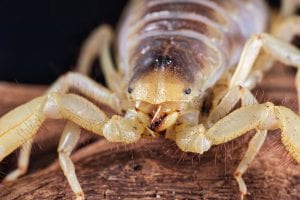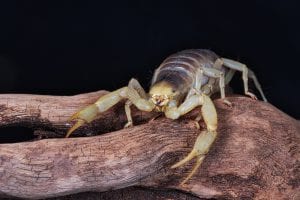The Desert Hairy Scorpion naturally occurs throughout the Sonoran and Mojave deserts in North America. The hairs detect vibrations and aid them catching prey in such harsh hot conditions. They live in long elaborate tunnels, up to around three metres long.
 They are known for being a grumpy species, however we find them to be a very manageable species that pose no great difficulties to the experienced scorpion keeper. Their venom is described as being comparable to a bee sting, – however even a bee sting can cause an allergic reaction, and fatalities from this scorpion species have been recorded. As with all species, be careful – and we advise only adult keepers.
They are known for being a grumpy species, however we find them to be a very manageable species that pose no great difficulties to the experienced scorpion keeper. Their venom is described as being comparable to a bee sting, – however even a bee sting can cause an allergic reaction, and fatalities from this scorpion species have been recorded. As with all species, be careful – and we advise only adult keepers.
A plastic or glass tank provides the most suitable housing, heated by a heat mat under or on the side (personal preferences). Always control the heat output with a thermostat, a simple 100w on / off thermostat will do the job. Maintain a temperature of around 26C. The best substrate to provide is ProRep Bio Life Desert, which will offer the ability to burrow and also provide differing levels of dampness. Flat rocks can also be utilised as hides. Provide a shallow water bowl.
All scorpions are insectivorous, please do not purchase this species if feeding live insects concerns you at all. In your thought process keep in  mind that it’s not unusual to have the odd cricket or other livefood to escape around the house. Also keep in mind that the livefood will also need to be looked after to keep it alive and more nutritionally viable. There are specially designed holding tanks, and special food for the insects (typically this is called “gutloading”) – this also passes the goodness to the scorpions too. Always dust food every other day with a good quality supplement powder. Again, a debatable topic, and there are many varieties of supplements. We tend to use and recommend VetArk Nutribal.
mind that it’s not unusual to have the odd cricket or other livefood to escape around the house. Also keep in mind that the livefood will also need to be looked after to keep it alive and more nutritionally viable. There are specially designed holding tanks, and special food for the insects (typically this is called “gutloading”) – this also passes the goodness to the scorpions too. Always dust food every other day with a good quality supplement powder. Again, a debatable topic, and there are many varieties of supplements. We tend to use and recommend VetArk Nutribal.
